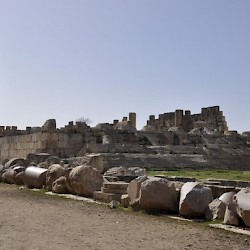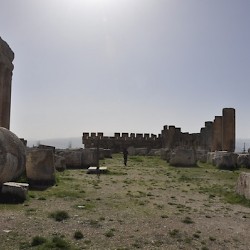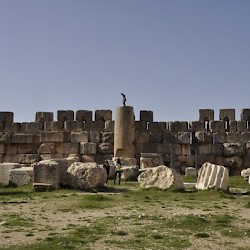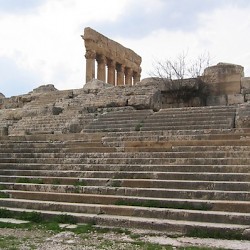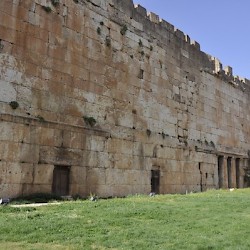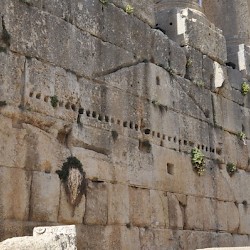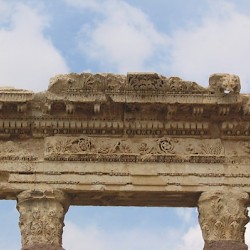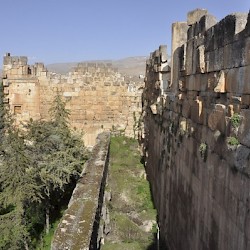Baalbek: Temple of Jupiter, Shrine
Q14524645Baalbek or Heliopolis (Ἡλιούπολις, "sun city"): town in the northern Bekaa valley, site of the largest sanctuary in the Roman world.
Temple of Jupiter: Shrine
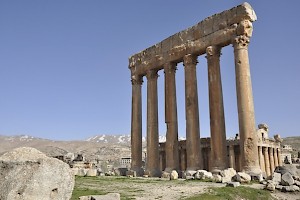
Rising above a wide flight of stairs, the shrine of the temple of Jupiter in Baalbek was the largest sanctuary in the Roman world, but little survives, except for six Corinthian columns on the south side, which are still carrying their entablature (the horizontal beams). The reason is that from the sixth century on, the temple was dismantled. The author known as ps.-Zacharias of Mytilene informs us that in 524/525, lightning destroyed the building,note and after that, the emperor Justinian (r.527-565) started to remove the granite columns (they may have been used in the Hagia Sophia in Constantinople). Later, in the age of the Crusades, the stones were reused to convert the complex into a fortress.
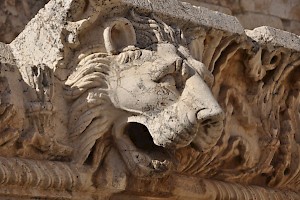
Measuring 88 x 48 meters, the temple was surrounded by no less than fifty-four columns: ten in the façade, twice nineteen along the long sides, and ten on the west side (the corner pillars must not be counted double). They were twenty-seven meters tall, had a diameter of 2¼ meters, and carried an entablature that was another five meters high. Inside were tall walls and more columns, which supported the massive roof, made of cedar wood.
This was a large place to gather snow in the winter, and there must have been a lot of melting water, so that it comes as no surprise that there were gargoyles. They had the shape of lions' heads. (Lions were sometimes associated with the sun.) It must have been a beautiful sight when, in the early days of spring, the melting water fell from a height of twenty-five meters.
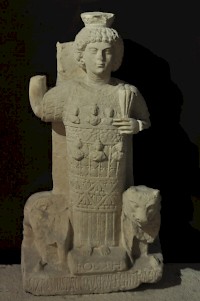
Inside the temple, which was only accessible for the priests, stood the cult statue of Jupiter Heliopolitanus. According to Macrobius, the it had been taken from Egypt, was made of gold, and showed the god as a beardless, young man, "with its right hand raised and holding a whip, like a charioteer," while the left hand held "a lightning bolt, and ears of grain".note There are several signet seals and other representations of the statue, which allow us to establish that the statue was flanked by two bulls (Hadad's animal), and that the god probably wore representations of the Sun and Moon on his breast. On his head, he wore a basket-shaped hat, a kalathos.
The temple is built on a terrace of 13 ½ meters high. Very large stones were used to build it. The three stones at the west end measured no less than 19 x 4 x 3 meters and weigh more than a thousand tons each. Together, they were called the trilithon, and ancient authors never tired of praising this wonder. (A similar stone can still be seen in the quarry.)
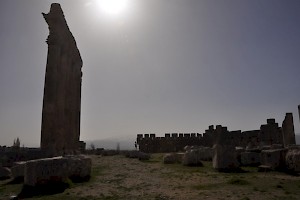
According to Michael the Syrian,note the cult statue was still standing during the reign of Justin II (r.565-578). However, this cannot be true, because lightning had destroyed the temple in 524/525. We already saw that this was reported by Pseudo-Zacharias of Mytilene, who also mentions that in his days, the temple had been converted into a church of Mary, mother of God.
Some of the columns were removed by sultan Süleyman the Magnificent, but at least nine of them were still standing in 1759, when an earthquake took place, leaving only six columns standing.
